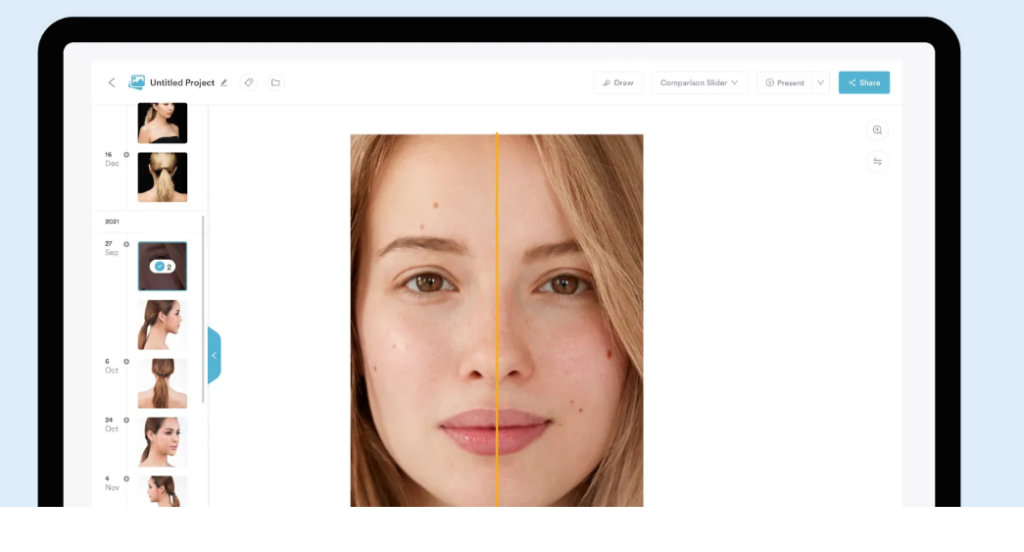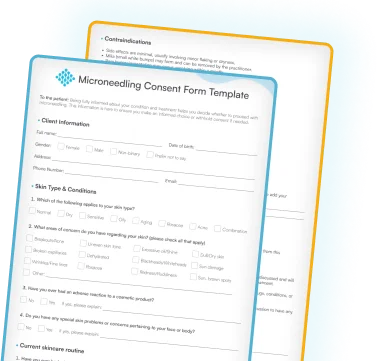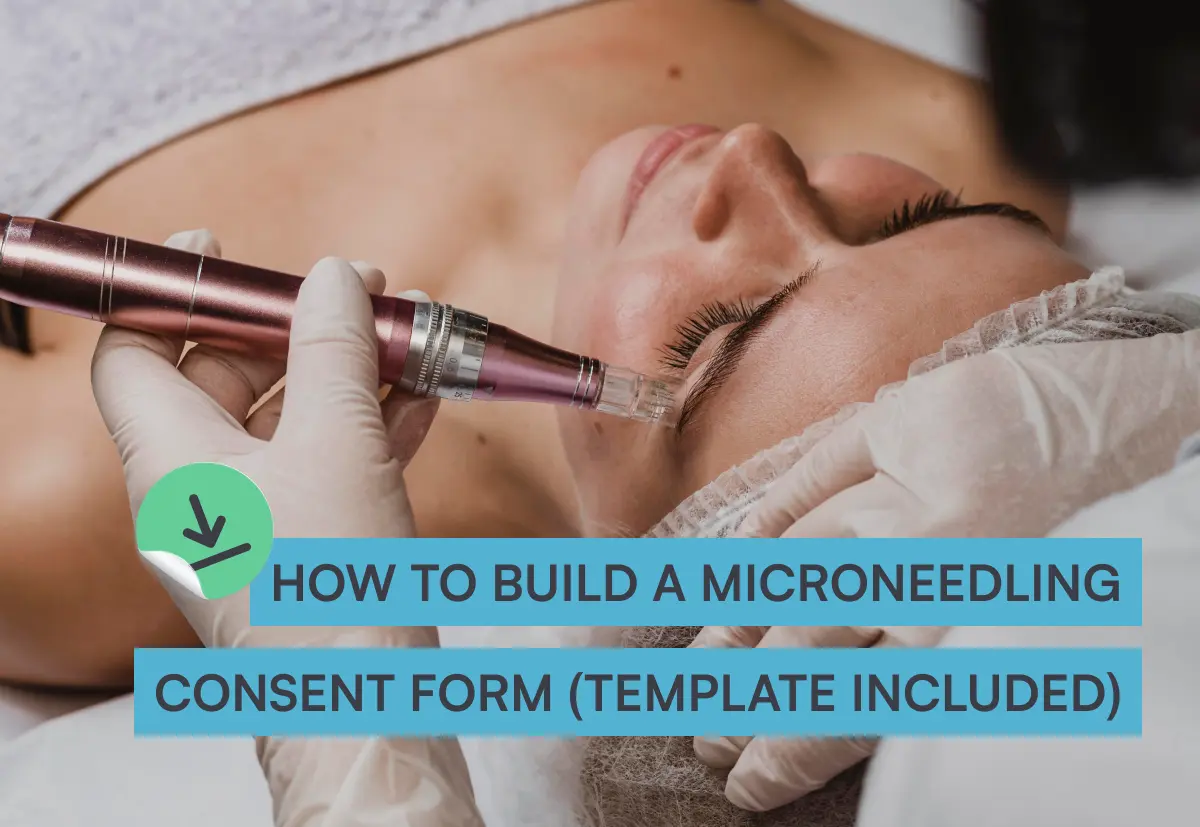Want the microneedling consent form template? Grab it right here!
There’s a good reason why micro-needling has become one of the go-to treatments in the skincare world – and in Hollywood!🤩Celebrities such as Kim Kardashian and even Brad Pitt are reported to have had it.
This ‘holy grail’ multi-purpose procedure is minimally invasive and can be performed all over the body, from scalp to ankles.
But before any needles touch the skin, there’s one crucial step: the consent form.
Microneedling consent forms are a vital safeguard for clients and the physician or aesthetician performing the treatment. They ensure the customer understands the treatment, and that this is carefully documented by the business.
In this blog, we’ll look at how you can build a microneedling consent form and what must be included. Plus, we give you a free template to download and use.
Key components of a microneedling consent form
Clear communication is key when it comes to microneedling treatments.
A well-structured consent form helps ensure the client is fully informed about the procedure and its potential risks, leading to fewer misunderstandings.
Let’s now take a look at what to include in these consent forms.
Client information
In this part, you want to the client’s basic details — like their full name, date of birth, gender, and contact information. This helps you send appointment reminders and follow-up instructions and reach out if anything is urgent.
Also, you want to collect vital medical history data. This information is the foundation for a safe, customized treatment experience, ensuring clients receive the most appropriate care based on their health profile.
Plus, accurate health information is key to determining whether the client is a suitable candidate for microneedling.
Make sure you know:
- The client’s skin type
- Any medical conditions
- Use of certain medications
You may find that microneedling may not be recommended at all.
Procedure description
The procedure description should give a clear overview of what the microneedling process looks like, so clients know what to expect.
The really important point here is to ensure the description makes sense to someone from a non-medical background. Explain that it’s a skin-rejuvenating procedure that uses tiny needles to create micro-injuries on the skin’s surface, stimulating natural collagen and elastic production for smoother, firmer skin.
You can also explain the tools used for the microneedling treatment, which are usually pen-like devices, and mention that they will be performed by a practitioner with adequate qualifications and skills. This is dependent on states!
Last but not least, you can add the length of time the treatment usually lasts, up to 30-60 minutes, depending on the area that will be treated.
Benefits of the treatment
Clients often choose microneedling for its ability to rejuvenate the skin.
They probably know that they treatment is good for getting younger-looking skin, but they might not know the exact benefits. That’s why a consent form is the perfect opportunity to outline what they’ll get out of it, such as:
- Reduced fine lines, fewer acne scars, smaller pores
- Improved hyperpigmentation through collagen stimulation, cell turnover, and improved product absorption
- Smoother skin texture and sometimes even hair regrowth on the scalp
Potential risks and side effects
As with other cosmetic procedures, microneedling has potential risks and side effects. Naturally, you want these included in your consent form so patients are informed of both the pros and the cons of the procedure.
Common side effects include temporary redness, swelling, or mild bruising, which typically subside within a few days. There are also rare but more serious complications, such as infection or scarring.
Clients should also be aware that results may take time to show as the skin heals. In other words, ensure you’re aligned on expectations before moving forward.
Post-treatment care instructions
Clients might assume they know how to care for their skin post-microneedling, but don’t risk skipping proper post-treatment instructions in the informed consent.
Personalized treatment plans are key here, ensuring clients receive guidance tailored to their needs. This approach not only supports the optimal healing process but also helps prevent complications.
Be sure to advise clients on:
- Avoiding sun exposure for at least 48 hours
- Skipping makeup on the treated area and using only gentle skincare products
- Steering clear of strenuous activities that cause excessive sweating, which could irritate the skin
Another tip is to also ensure you send your post-care instructions to clients via email, rather than just communicating it verbally or via a leaflet. Not only does it mean the client has it to refer to, it also means it’s documented in the system.
Contraindications
Generally, microneedling treatments are safe, but there is always a possibility or risk, making this procedure unsuitable for some clients.
These may include:
- Clients with active acne, warts, or other fungal infections
- Clients with eczema, psoriasis, cold sores, or rosacea skin conditions, which can lead to heightened skin sensitivity or trigger flare-ups
- Anyone prone to keloid scars may experience abnormalities such as wound healing
Additionally, clients taking medication drugs such as blood thinners, immunosuppressants, Accutane, and similar types of products have a bigger risk of bleeding during the procedure, reducing the skin’s ability to heal properly.
Photography and use of images
Like other facial treatments and aesthetic procedures, physicans and estheticians often take photos of their clients for record-keeping, before-and-after comparisons, and even marketing purposes.

If you, too, want to take pre- and post-treatment pictures of your clients, it’s non-negotiable to get your client’s go-ahead. You can handle this and make sure they feel comfortable by:
- Explaining to them why you need those pictures and how they’ll be used
- Explaining that their photos will stay private and stored securely
- Getting explicit consent if you want to use their photos for marketing purposes
Also, remember that clients have the legal right to say no. So, your consent form should have the option to decline having photos taken with the explanation that this won’t affect their treatment.
Acknowledgement and understanding
Clients must confirm that they fully understand the procedure, its benefits, and the potential risks.
So, this section typically includes a statement like “I have read and understand the information provided and consent to the microneedling treatment.”
Also, in this part of the form, you can encourage clients to ask any questions or address any concerns they may have. This conversation builds trust and helps clients feel comfortable and sure about their choices, setting things up for a safe and smooth experience.
Client and practitioner signatures
Without the client’s and the practitioner’s signatures on the consent form, your consent form might as well not exist.
Signatures must be added to formalize the microneedling consent and make it official that the client agrees to the treatment they’re about to have.
These signatures also act as a legal record that informed consent was obtained before proceeding with the treatment.
Microneedling consent form template

Microneedling Consent Form
Template for download
How to present the consent form to clients
Most clients aren’t aware that filling out consent forms is a crucial step before treatment. It’s your responsibility to ensure clients complete forms before appointments and present them in a clear and friendly manner.
Here are a few tips on how to make this process smooth and efficient:
- Create a comfortable environment: Make sure your clients feel relaxed and never rushed when filling out the form
- Explain the form thoroughly: Walk them through each section, answering any questions they may have along the way
- Give them time to review the form and encourage questions: Give clients enough time to read and understand it and remind them to ask about anything they’re unsure about before signing
💡Go paperless with digital consent forms:
Clients appreciate the convenience of digital forms, especially when they can complete at home or on their own time. They’re also more seamless from an operations perspective, as you can access them securely from anywhere.
Pabau lets you create, customize, and send digital consent forms, which can be sent for e-signature automatically… or handed to the client via an iPad or iPhone in person before the treatment. Much simpler!
Automate and organize your consent forms with Pabau
Now that you know how to build microneedling consent forms, it’s equally essential to learn how to manage and send them without a hassle.
Luckily, Pabau is here to help.
Pabau is an all-in-one practice management software that allows you to streamline and automate your microneedling consent forms digitally, all while ensuring they are easily accessible and securely stored.
And that’s not all—it can also help you with:
✅ Auto-flagging any client allergies and contraindications
✅ Automatically sending out microneedling consent forms
✅ Letting clients fill forms from anywhere, on any device
✅ Automatically sending pre-care and post-care information
✅ Saving resources and keeping you organized — no more paper forms!
In other words, with Pabau, building a microneedling consent form is a piece of cake.
Book a product demo today and see for yourself!✨




